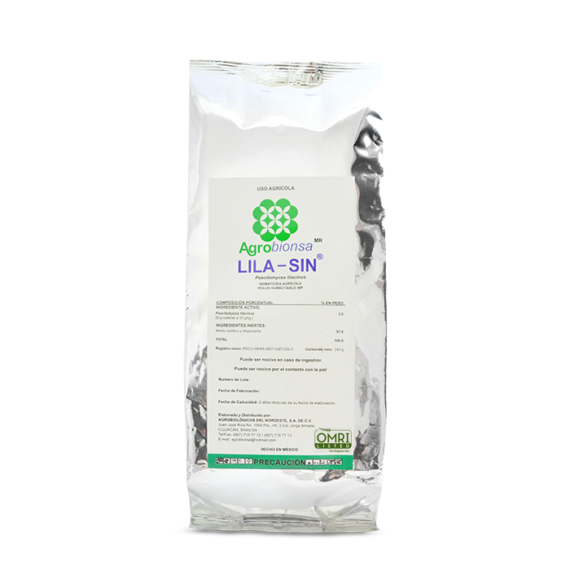LILA–SIN®
Purpureocilium lilacinum (Paecilomyces lilacinus) | Cepa ABNPI 329
This bionematicide is biotechnologically developed to parasitize several species of phytoparasitic nematodes.
Details
Concentration: 5.0 X 10⁹ Conidia/g equals to 1.2 x 10¹² Paecilomyces lilacinus conidium in 240 g
Presentation: Wettable powder 240 g
Plagues: Root-knot nematode (Meloidogyne incognita)
Crops: Bell peppers, tobacco, tomatoes, tomatillos, potatoes, and eggplants
Characteristics
LILA–SIN® is formulated with conidia of a Paecilomyces lilacinus strain, designed to act on nematodes’ eggs and females. In the eggs, it prevents the hatching and in the females, it affects their nervous system as well as their reproductive capacity. In addition, when LILA–SIN® fungus grows in the soil, it produces substances that affect phytopathogenic nematodes development.
Benefits
- Controls insect pests
- High degree of specificity
- Can be used at all stages of plant development
- Allows harvesting after application (Zero-hour re-entry interval)
- Strengthens the development of healthier plants, and improves crop quality and crop yield
- Does not harm the ecosystem because its active ingredient is a microorganism found in nature. It is innocuous and has no toxic residues
- Synergistic in Integrated Pest Management (IPM) practices. It is compatible with agricultural products. Please refer to the Agrobionsa’s products compatibility table for detailed information
- Prevents secondary pest development
- Suitable for resistance management. It does not generate resistance in the pathogens they attack
- Promotes horizontal dissemination
- Compatible with beneficial insects and pollinators because it does not harm their populations
- OMRI (Organic Materials Review Institute) Certified. It can be used in organic agriculture
- COFEPRIS (Mexican Federal Commission for the Protection against Sanitary Risk) registered product

RSCO-NEMA-0907-X0011-002-3
At the following link:
Consulta COFEPRIS
- Select “Pesticidas”.
- Enter the following code: RSCO-NEMA-0907-X0011-002-3
- Click on “Buscar”.
Moment of application
To control the diseases that penetrate the root, LILA–SIN® must be applied to seed preparation, during transplant, and from the first irrigation. To control foliar diseases, LILA–SIN® is to be applied at the early detection of pest populations. The range of applications depends on the degree of crop infestation, environmental conditions, and reinfestation.
Application mode
Apply 240 g – 480 g of LILA–SIN® per hectare in seed treatments, seed trays, drip irrigation equipment, and applications directed to the plant base and foliage.
Prepare a premix, place it in the application equipment tank and complete the volume of the application mixture with water. Ensure pH between 5.5 and 7.0.
Preparation of the premix
In a container with 15 L of water with a pH between 5.5 and 7.0 and hardness less than 150 ppm, add LILA–SIN® and stir until obtaining a homogeneous mixture. If needed, use pH and/or hardness adjusters.
Preparation of the mixture for the application
To make the mixture in the application equipment tank, add the dispersant, the acidifier, and water to half of the application volume.
Then, stir the premix and empty it into the application equipment tank. Complete the volume of the application mixture with water.
For good foliar coverage, utilize 100 L to 250 L of water/ha in terrestrial applications. In aerial applications, utilize 60 L to 80 L of water/ha.



